This question arose from an answer to my recent question How many traces are there on Temperley-Lieb, Fuss-Catalan, Iwahori-Hecke, Birman-Wenzl-Murakami-Kauffman, ... algebras?
What I need from that answer here is combination of the following facts.
0) Let $V$ be the standard (2-dimensional) representation of the Lie algebra $\mathfrak{sl}_2$ (over complex numbers, say).
1) Dimension of the algebra $\operatorname{End}_{\mathfrak{sl}_2}(V^{\otimes n})$ is $C_n$, the $n$-th Catalan number.
2) Let $V^{\otimes n}=m_{n,0}\mathbf{1}\oplus m_{n,1}V\oplus m_{n,2}S^2(V)\oplus m_{n,3}S^3(V)\oplus\cdots$ be the decomposition into irreducible representations of $\mathfrak{sl}_2$, then the above endomorphism algebra decomposes accordingly into the product of full square matrix algebras $\operatorname{Mat}_{m_{n,0}}\times\operatorname{Mat}_{m_{n,1}}\times\operatorname{Mat}_{m_{n,2}}\times\cdots$.
3) It follows easily from the formula $V\otimes S^k(V)\cong S^{k-1}(V)\oplus S^{k+1}(V)$ used in the above answer that the numbers $m_{n,k}$ form the Catalan triangle
1
0 1
1 0 1
0 2 0 1
2 0 3 0 1
0 5 0 4 0 1
5 0 9 0 5 0 1
That is, $m_{n,k}=m_{n-1,k-1}+m_{n-1,k+1}$ for $k\geqslant0$ (starting from $m_{0,0}=1$ and with $m_{n,k}=0$ for $k<0$ or $k>n$).
It thus follows from the above matrix algebra decomposition that the sum of squares of the numbers in the rows of this triangle are the Catalan numbers.
The latter fact seems to be well known. At least it is mentioned at the OEIS page to which my above link points. At that page there also is the formula $m_{n,k}=\frac{k+1}{n+1}\binom{n+1}{\frac{n-k}2}$ (for $n\equiv k\mod 2$, otherwise it is zero).
My question is whether a combinatorial interpretation of this is known. Specifically, whether there are some combinatorial objects enumerated by $m_{n,k}$ such that $C_n$ equals the number of pairs of such objects with equal $k$'s.
LATER
After much hesitation I decided to accept the answer by Qiaochu Yuan. The reason is purely egotistic - that answer helped me personally better to understand the picture (which I reflected in my own answer).

